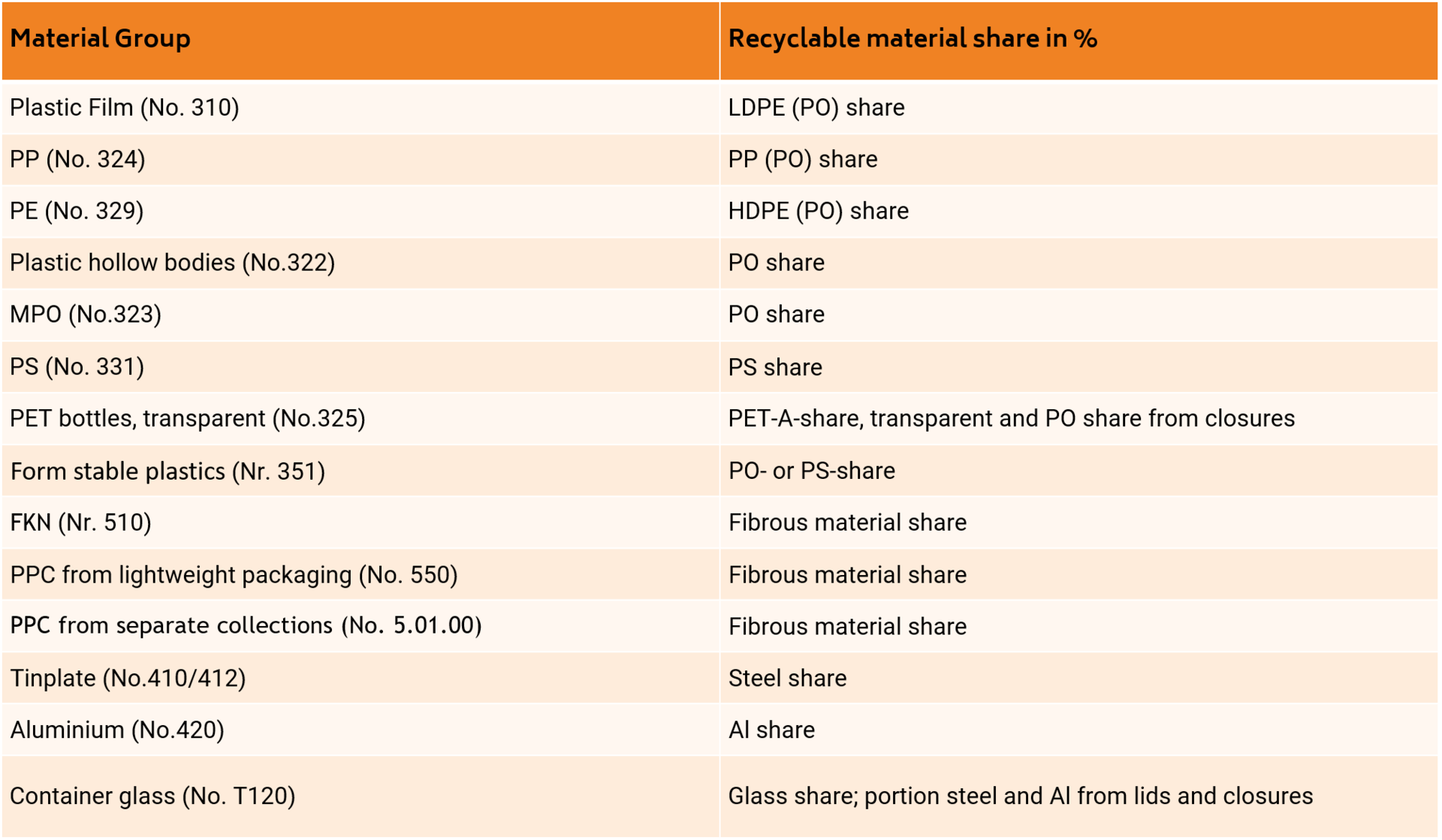
Turn old into new - what about the recyclability of your packaging?
All information on recyclable packaging according to the minimum standard of the Central Agency
What does recyclable mean?
Packaging is recyclable, if a sorting and recovery infrastructure is available for it after use, if it can be sorted as a whole or if the individual components can be separated from each other in the recycling process. In addition, recyclable packaging does not contain any incompatibilities such as material combinations or substances that could prevent subsequent recycling success. Ultimately, packaging is recyclable, if it can replace new material in material-typical applications after recycling. This is the only way to keep raw materials in the recycling loop and therefore reduce CO2 emissions.
For the assessment of the recyclability of packaging, the Central Agency Packaging Register has published a minimum standard. If you need assistance in determining recyclability, we will be happy to help you with our consulting services: Recyclable Packaging
Why is recyclable packaging so important?
The careful use of our finite resources is one of the environmental issues of our time. That is why recyclability is becoming increasingly important when it comes to designing packaging. Plastic packaging, for example, is made from the fossil raw material oil, paper is made from wood fibres. The better a packaging can be recycled, the more raw materials are protected and the more environmentally friendly the packaging itself is and the higher the CO2 savings through recycling. For example, recycling one tonne of ...
▶ used paper packaging saves 979 kg of CO2 compared to incineration.
▶ used glass packaging saves 283 kg of CO2 compared to incineration.
▶ used aluminium packaging saves 6.782 kg of CO2 compared to incineration.
▶ used polystyrene packaging saves 4.683 kg of CO2 compared to incineration.
In order to provide the best possible support to manufacturers of packaging and to work together to achieve the recycling rates set by law, Circpack by Veolia and BellandVision are making their recycling guidelines available.
How can I determine the recyclability of a packaging?
The minimum standard of the Central Agency ("ZSVR") for assessing the recyclability of packaging is complex and therefore poses challenges for distributors over and over again. To make it easier for you to gain an overview and to provide you with the best possible support in optimising your packaging, BellandVision has developed an online tool for assessing the recyclability of packaging (recycling tool). With just a few clicks, you can easily determine whether and to what extent your packaging is recyclable - and then receive tips for optimisation.
The software is available to BellandVision customers upon request. If you are interested, we look forward to hearing from you.
How can I improve the recyclability of my packaging?
Further optimising the recyclability of packaging and therefore protecting our environment is firmly anchored in BellandVision's corporate philosophy: The future needs recycling. From the very beginning, we have relied on intensive cooperation with packaging producers and packaging distributors. Because how recyclable a package ultimately is is already decided in the design and optimal planning of the material components.
That's why we offer our customers tailor-made solutions to improve the recyclability of their packaging: From an online tool to measure the recyclability of existing packaging, to detailed guidelines on design for recycling, to informative workshops, we are there to support you with our experience in the field of recycling and our Europe-wide network.
You can find an overview of our consulting services here: Improve the recyclability of packaging
How can I determine the recyclability of a packaging?
The Central Agency Packaging Register has published a minimum standard for the assessment of recyclability. Whether and to what extent packaging is recyclable according to the Packaging Act depends on the three minimum criteria:
▶ Is there a suitable sorting and recovery infrastructure for high-quality mechanical recycling of the packaging?
▶ Can the packaging be correctly sorted and separated into its individual material components within the recycling cycle?
▶ Does the packaging contain combinations of materials or substances that can prevent the recycling success?
You can easily determine the recyclability of your packaging using our online tool. The software is available to BellandVision customers upon request. If you are interested, please contact us.
What is the object of assessment when determining recyclability?
The object of assessment for determining recyclability is always the complete unfilled packaging including all components (labels, sealing foils, adhesives, closures, etc.). An assessment of recyclability on the basis of individual packaging components as a result of a theoretical disassembly of the packaging is not permissible. The components of combination packaging can only be measured separately if they are typically disposed of separately by the consumer during use or consumption. The question whether it is necessary for the consumer to separate the individual components irrevocably and completely, e.g. toothpaste tube and folding box, can also help here. If so, these components are individual parts of a combination packaging.
The assessment of packaging groups is allowed, if the individual packagings in such a group have the same material structure and otherwise differ only in the contents and/or filling quantity, but not in relevant process-specific criteria. Classification as one packaging group is not possible, e.g. for plastic articles which are identical in their material structure, but are only partially accessible for sorting due to their different colouring.
What is meant by sortability and separability of a packaging?
Packaging made of glass, plastics (except for the film fraction), liquid cartons and PPK are sorted by machine using sensor-based recognition. The more reliably a packaging can be recognised, the better its recyclability.
The separability of packaging components must be possible in the reprocessing process. Above all, packaging made of paper, cardboard or paperboard must be able to be separated into fibres during pulping. A wet-strength coating on both sides would prevent this disintegration, which would result in this packaging being discarded as residue. This in turn would prevent recycling.
What is meant by recycling incompatibilities?
If certain material combinations or substances are used in the packaging design, which negatively affect or worsen the recyclability, those are referred to as recycling incompatabilities. As part of the minimum standards for the assessment of the recyclability of packaging, the Central Agency Packaging Register provides an overview of material-specific recycling incompatibilities. You can find it here.
What recyclable material content may be taken into account when determining the recyclability of my packaging (in %)?
The recyclable content, which is used to measure the recyclability of packaging, depends on the packaging material. The recyclable material content of a packaging expressed in percent by mass, also represents the recyclable portion of a packaging. According to the Central Agency Packaging Register, these recyclable types of material are taken into account for the following material groups:
